Case Study: Comprehensive Analysis of Acute Severe Asthma Management
VerifiedAdded on 2023/06/04
|17
|3100
|115
Case Study
AI Summary
This case study provides a detailed analysis of acute severe asthma, beginning with its pathogenesis, including airway effects, epithelial damage, mucus hypersecretion, oedema, bronchospasm, and airway remodelling. It then discusses diagnostic methods such as electrocardiograms, arterial blood gas analysis, and peak expiratory flow. The study emphasizes the role of nursing strategies, including oxygen therapy and patient positioning, in managing the condition. Furthermore, it elaborates on drug administration, specifically nebulized salbutamol, ipratropium bromide, and IV hydrocortisone, detailing their modes of action, side effects, and necessary nursing interventions. The case study concludes with a summary diagram linking aetiology, pathogenesis, clinical features, risk factors, complications, treatment, and nursing interventions, offering a comprehensive overview of acute severe asthma management. Desklib provides similar solved assignments and past papers for students.

Running Head: ASTHMA PROBLEMS 0
ACUTE SEVERE ASTHMA
Student Name
ACUTE SEVERE ASTHMA
Student Name
Paraphrase This Document
Need a fresh take? Get an instant paraphrase of this document with our AI Paraphraser

ASTHMA PROBLEMS 1
Table of Contents
Section one.................................................................................................................................................................................................................................... 2
Pathogenesis.............................................................................................................................................................................................................................. 2
Diagnosis of Acute severe asthma............................................................................................................................................................................................. 4
Section 2........................................................................................................................................................................................................................................ 5
Nursing strategies to manage..................................................................................................................................................................................................... 5
Section 3........................................................................................................................................................................................................................................ 7
Drug Administration.................................................................................................................................................................................................................. 7
Nebulised Salbutamol............................................................................................................................................................................................................ 7
Ipratropium bromide.............................................................................................................................................................................................................. 8
IV hydrocortisone 100 mg..................................................................................................................................................................................................... 9
References................................................................................................................................................................................................................................... 14
Table of Contents
Section one.................................................................................................................................................................................................................................... 2
Pathogenesis.............................................................................................................................................................................................................................. 2
Diagnosis of Acute severe asthma............................................................................................................................................................................................. 4
Section 2........................................................................................................................................................................................................................................ 5
Nursing strategies to manage..................................................................................................................................................................................................... 5
Section 3........................................................................................................................................................................................................................................ 7
Drug Administration.................................................................................................................................................................................................................. 7
Nebulised Salbutamol............................................................................................................................................................................................................ 7
Ipratropium bromide.............................................................................................................................................................................................................. 8
IV hydrocortisone 100 mg..................................................................................................................................................................................................... 9
References................................................................................................................................................................................................................................... 14

ASTHMA PROBLEMS 2
Section one
Pathogenesis
Acute severe asthma is defined as the serious health issue that is not treated with the repeated course of treatments with Beta2 antagonist
medicines. The person experiencing the acute severe asthma attack often required emergency treatment in an emergency department of a hospital
(Sandrock, & Norris, 2015). Causes of this disorder include outdoor allergens like pollen, smoking, indoor, air pollution, infections of lungs or
other parts of the respiratory system, socio-economic status, and chemicals. Some of the trigger factors that can cause this condition include
pollutants, sulphur dioxide, exercise, irritants, emotions like stress, and change in weather (Lommatzsch, & Virchow, 2014). There are five
different pathogenesis mechanisms are responsible for the occurrence of this disease such as asthma affected Airway, damage of the epithelial
part, high secretion of mucus, oedema, bronchospasm, and remodelling of the airway.
Asthma affected Airways
As discussed in the case study Mr Jackson had clinical manifestations like severe dyspnoea, unable to speak complete sentence in a
single breath, respiration rate of 32 breaths/min, BP 150/85 mmHg, pulse rate 1340 beats/min, diminished breath sounds and wheezing sound.
These manifestations are associated with various pathogenic pathways. The consequences of asthma can affect some part of the respiratory
Section one
Pathogenesis
Acute severe asthma is defined as the serious health issue that is not treated with the repeated course of treatments with Beta2 antagonist
medicines. The person experiencing the acute severe asthma attack often required emergency treatment in an emergency department of a hospital
(Sandrock, & Norris, 2015). Causes of this disorder include outdoor allergens like pollen, smoking, indoor, air pollution, infections of lungs or
other parts of the respiratory system, socio-economic status, and chemicals. Some of the trigger factors that can cause this condition include
pollutants, sulphur dioxide, exercise, irritants, emotions like stress, and change in weather (Lommatzsch, & Virchow, 2014). There are five
different pathogenesis mechanisms are responsible for the occurrence of this disease such as asthma affected Airway, damage of the epithelial
part, high secretion of mucus, oedema, bronchospasm, and remodelling of the airway.
Asthma affected Airways
As discussed in the case study Mr Jackson had clinical manifestations like severe dyspnoea, unable to speak complete sentence in a
single breath, respiration rate of 32 breaths/min, BP 150/85 mmHg, pulse rate 1340 beats/min, diminished breath sounds and wheezing sound.
These manifestations are associated with various pathogenic pathways. The consequences of asthma can affect some part of the respiratory
⊘ This is a preview!⊘
Do you want full access?
Subscribe today to unlock all pages.

Trusted by 1+ million students worldwide

ASTHMA PROBLEMS 3
system such as Trachea, bronchi and the bronchioles. It can also cause hyper secreting mucous, bronchoconstriction or airway narrowing of
airways, oedema, and damaged muscles. Mr Jackson had low levels of PaO2, pH and PaCO2, which are associated with the pathogenesis of
acute severe asthma.
Damage of epithelial layers
The lining of the airways lining can be damaged. Shedding of the epithelium layer can lead to hyper-responsiveness of the airway by
different by different methods like loss of barrier function, loss of enzymes and exposure of nerves.
Mucus Hyper secretion and oedema
The mucous gland expands in asthma due to the multiple divisions of mucous secreting cells that are present in the airway. This hyper
secretion may also result in the development of viscid plugs of the mucus that may occlude airways. Leakage and dilation of airways capillary
walls might occur. This may further cause hyper-responsiveness and narrow airway. These are the reason the patient has the pulse rate of 130
bpm, blood 150/85 mmHg blood pressure. Oedema is the main reason behind the low levels of pH in case of Mr Jackson (Endo, Hirahara, Yagi,
Tumes, & Nakayama, 2014). The patient had HCO3 (bicarbonate ion) level of 25mEq/L, which is considered normal.
Bronchospasm and Airway remodelling
system such as Trachea, bronchi and the bronchioles. It can also cause hyper secreting mucous, bronchoconstriction or airway narrowing of
airways, oedema, and damaged muscles. Mr Jackson had low levels of PaO2, pH and PaCO2, which are associated with the pathogenesis of
acute severe asthma.
Damage of epithelial layers
The lining of the airways lining can be damaged. Shedding of the epithelium layer can lead to hyper-responsiveness of the airway by
different by different methods like loss of barrier function, loss of enzymes and exposure of nerves.
Mucus Hyper secretion and oedema
The mucous gland expands in asthma due to the multiple divisions of mucous secreting cells that are present in the airway. This hyper
secretion may also result in the development of viscid plugs of the mucus that may occlude airways. Leakage and dilation of airways capillary
walls might occur. This may further cause hyper-responsiveness and narrow airway. These are the reason the patient has the pulse rate of 130
bpm, blood 150/85 mmHg blood pressure. Oedema is the main reason behind the low levels of pH in case of Mr Jackson (Endo, Hirahara, Yagi,
Tumes, & Nakayama, 2014). The patient had HCO3 (bicarbonate ion) level of 25mEq/L, which is considered normal.
Bronchospasm and Airway remodelling
Paraphrase This Document
Need a fresh take? Get an instant paraphrase of this document with our AI Paraphraser

ASTHMA PROBLEMS 4
Bronchospasm is basically an asthma feature that can be described as the sharp contraction of the soft muscles of the bronchial part, and
causes airways narrowing. This abnormal functioning or airways and lack of oxygen in airways were the reason of low levels of PaO2 and
PaCo2 in case of Mr Jackson Smith.
Uncontrolled and untreated asthma of the lower respiratory tract may cause various changes in cells and the tissues that may result in
airways remodelling and fibrotic damage. In the given case study the person was unable to finish a sentence in single breath due to tachypnoea in
which the intra-thoracic pressure increases and the inhalation and exhalation of air from alveoli are become difficult. The normal range of
oxygen saturation (SPO2) in an adult is 95 to 100 %, in case of Mr Jackson the SPO2 levels were observed low (90%), which was caused due to
the low oxygen levels in high levels of CO2 due to airways obstruction or narrowing of airways (Olin & Wechsler, 2014).
Diagnosis of Acute severe asthma
Although this can be done by observing the symptom that can be seen on the asthma attack, there are some methods of identifying the
issue.
Electrocardiogram
Some of the characteristics of acute severe asthma need to be viewed as the alarming sign of the ventilator failure and these
characteristics are called red flags. For the initial assessment, an electrocardiogram can be used for the initial assessment to diagnose the sign of
strain that caused in the right side of the heart (Sudheer, Sasidhar, Prataprao, & Priyadarsini, 2015).
Bronchospasm is basically an asthma feature that can be described as the sharp contraction of the soft muscles of the bronchial part, and
causes airways narrowing. This abnormal functioning or airways and lack of oxygen in airways were the reason of low levels of PaO2 and
PaCo2 in case of Mr Jackson Smith.
Uncontrolled and untreated asthma of the lower respiratory tract may cause various changes in cells and the tissues that may result in
airways remodelling and fibrotic damage. In the given case study the person was unable to finish a sentence in single breath due to tachypnoea in
which the intra-thoracic pressure increases and the inhalation and exhalation of air from alveoli are become difficult. The normal range of
oxygen saturation (SPO2) in an adult is 95 to 100 %, in case of Mr Jackson the SPO2 levels were observed low (90%), which was caused due to
the low oxygen levels in high levels of CO2 due to airways obstruction or narrowing of airways (Olin & Wechsler, 2014).
Diagnosis of Acute severe asthma
Although this can be done by observing the symptom that can be seen on the asthma attack, there are some methods of identifying the
issue.
Electrocardiogram
Some of the characteristics of acute severe asthma need to be viewed as the alarming sign of the ventilator failure and these
characteristics are called red flags. For the initial assessment, an electrocardiogram can be used for the initial assessment to diagnose the sign of
strain that caused in the right side of the heart (Sudheer, Sasidhar, Prataprao, & Priyadarsini, 2015).
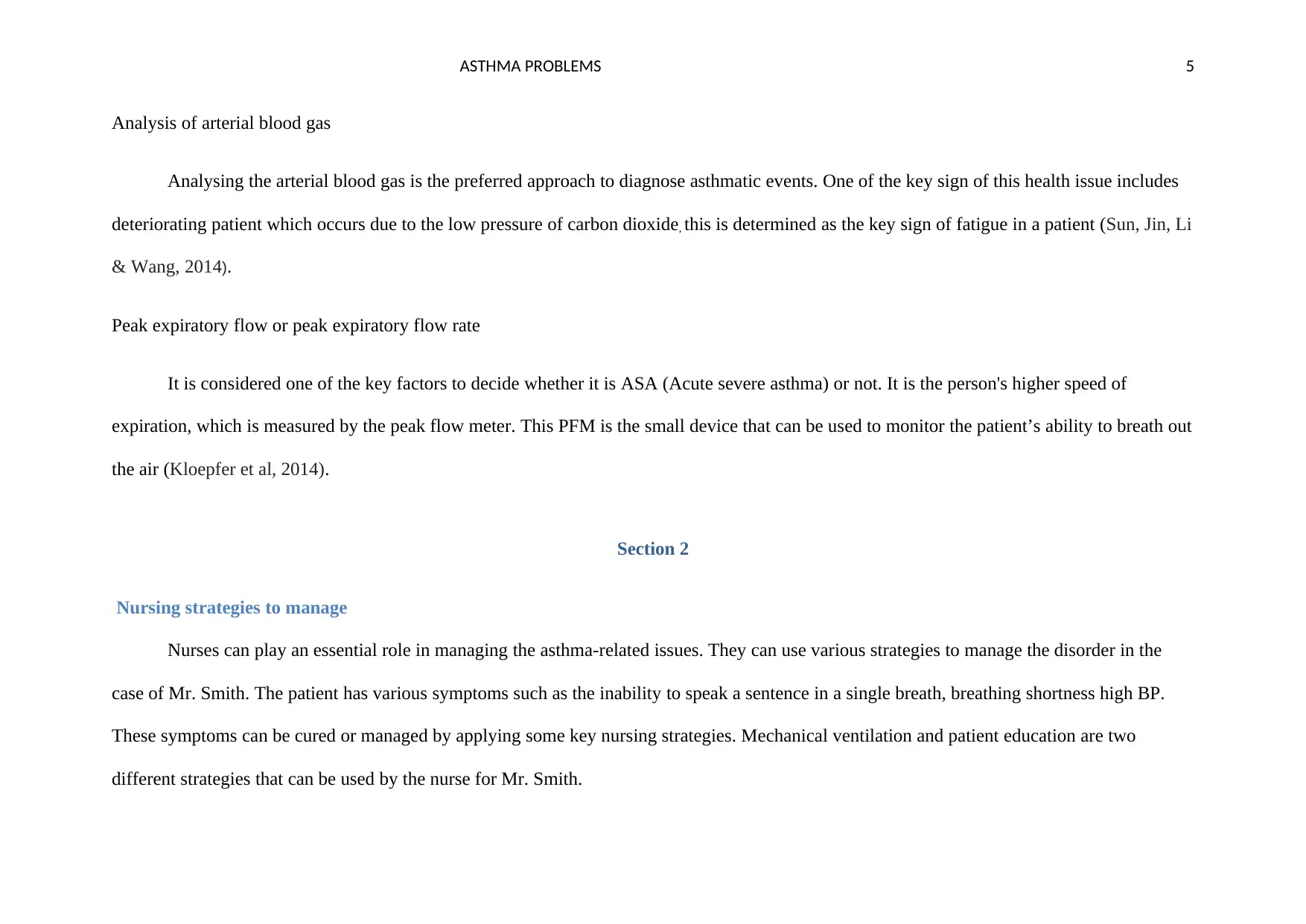
ASTHMA PROBLEMS 5
Analysis of arterial blood gas
Analysing the arterial blood gas is the preferred approach to diagnose asthmatic events. One of the key sign of this health issue includes
deteriorating patient which occurs due to the low pressure of carbon dioxide, this is determined as the key sign of fatigue in a patient (Sun, Jin, Li
& Wang, 2014).
Peak expiratory flow or peak expiratory flow rate
It is considered one of the key factors to decide whether it is ASA (Acute severe asthma) or not. It is the person's higher speed of
expiration, which is measured by the peak flow meter. This PFM is the small device that can be used to monitor the patient’s ability to breath out
the air (Kloepfer et al, 2014).
Section 2
Nursing strategies to manage
Nurses can play an essential role in managing the asthma-related issues. They can use various strategies to manage the disorder in the
case of Mr. Smith. The patient has various symptoms such as the inability to speak a sentence in a single breath, breathing shortness high BP.
These symptoms can be cured or managed by applying some key nursing strategies. Mechanical ventilation and patient education are two
different strategies that can be used by the nurse for Mr. Smith.
Analysis of arterial blood gas
Analysing the arterial blood gas is the preferred approach to diagnose asthmatic events. One of the key sign of this health issue includes
deteriorating patient which occurs due to the low pressure of carbon dioxide, this is determined as the key sign of fatigue in a patient (Sun, Jin, Li
& Wang, 2014).
Peak expiratory flow or peak expiratory flow rate
It is considered one of the key factors to decide whether it is ASA (Acute severe asthma) or not. It is the person's higher speed of
expiration, which is measured by the peak flow meter. This PFM is the small device that can be used to monitor the patient’s ability to breath out
the air (Kloepfer et al, 2014).
Section 2
Nursing strategies to manage
Nurses can play an essential role in managing the asthma-related issues. They can use various strategies to manage the disorder in the
case of Mr. Smith. The patient has various symptoms such as the inability to speak a sentence in a single breath, breathing shortness high BP.
These symptoms can be cured or managed by applying some key nursing strategies. Mechanical ventilation and patient education are two
different strategies that can be used by the nurse for Mr. Smith.
⊘ This is a preview!⊘
Do you want full access?
Subscribe today to unlock all pages.

Trusted by 1+ million students worldwide
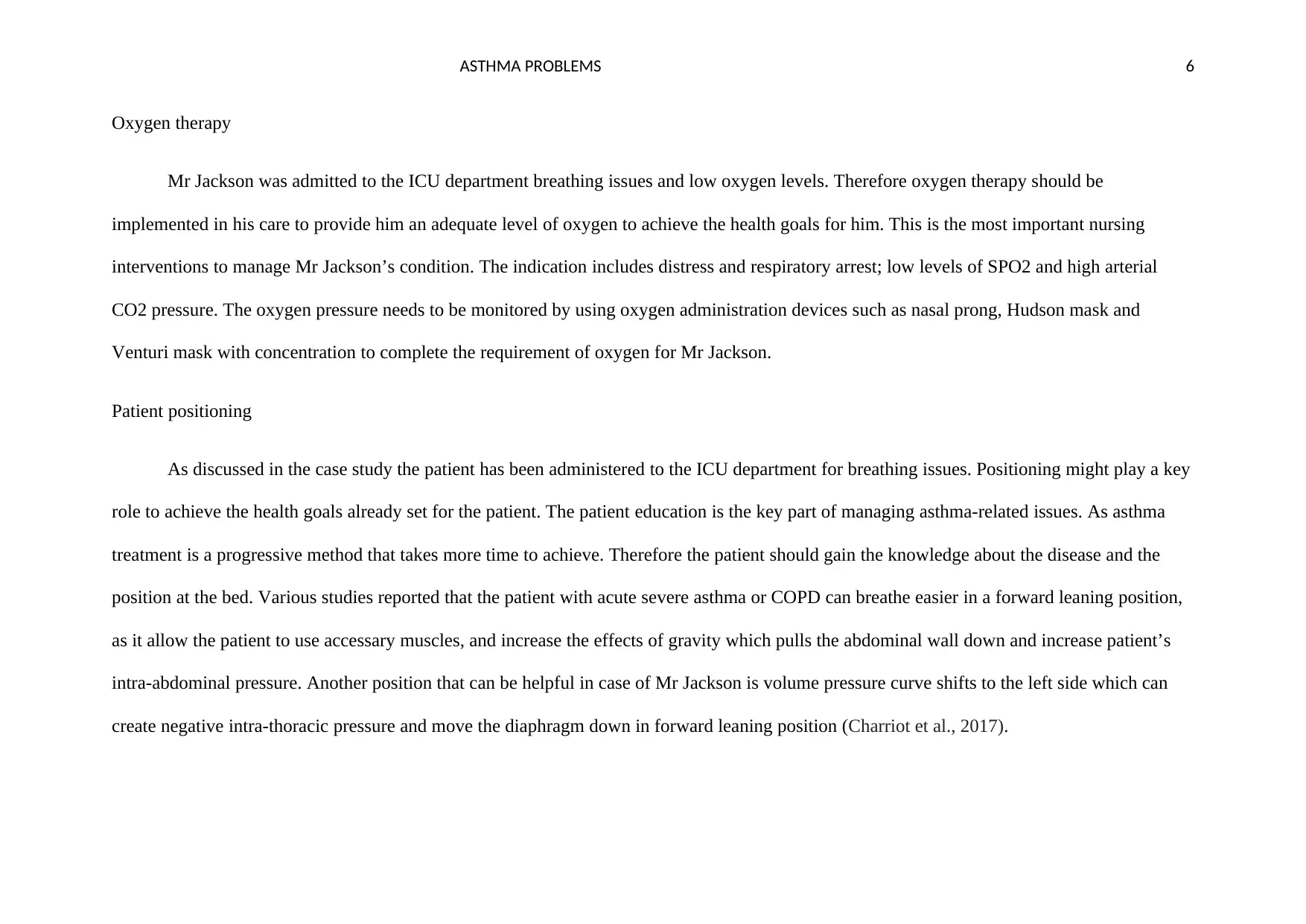
ASTHMA PROBLEMS 6
Oxygen therapy
Mr Jackson was admitted to the ICU department breathing issues and low oxygen levels. Therefore oxygen therapy should be
implemented in his care to provide him an adequate level of oxygen to achieve the health goals for him. This is the most important nursing
interventions to manage Mr Jackson’s condition. The indication includes distress and respiratory arrest; low levels of SPO2 and high arterial
CO2 pressure. The oxygen pressure needs to be monitored by using oxygen administration devices such as nasal prong, Hudson mask and
Venturi mask with concentration to complete the requirement of oxygen for Mr Jackson.
Patient positioning
As discussed in the case study the patient has been administered to the ICU department for breathing issues. Positioning might play a key
role to achieve the health goals already set for the patient. The patient education is the key part of managing asthma-related issues. As asthma
treatment is a progressive method that takes more time to achieve. Therefore the patient should gain the knowledge about the disease and the
position at the bed. Various studies reported that the patient with acute severe asthma or COPD can breathe easier in a forward leaning position,
as it allow the patient to use accessary muscles, and increase the effects of gravity which pulls the abdominal wall down and increase patient’s
intra-abdominal pressure. Another position that can be helpful in case of Mr Jackson is volume pressure curve shifts to the left side which can
create negative intra-thoracic pressure and move the diaphragm down in forward leaning position (Charriot et al., 2017).
Oxygen therapy
Mr Jackson was admitted to the ICU department breathing issues and low oxygen levels. Therefore oxygen therapy should be
implemented in his care to provide him an adequate level of oxygen to achieve the health goals for him. This is the most important nursing
interventions to manage Mr Jackson’s condition. The indication includes distress and respiratory arrest; low levels of SPO2 and high arterial
CO2 pressure. The oxygen pressure needs to be monitored by using oxygen administration devices such as nasal prong, Hudson mask and
Venturi mask with concentration to complete the requirement of oxygen for Mr Jackson.
Patient positioning
As discussed in the case study the patient has been administered to the ICU department for breathing issues. Positioning might play a key
role to achieve the health goals already set for the patient. The patient education is the key part of managing asthma-related issues. As asthma
treatment is a progressive method that takes more time to achieve. Therefore the patient should gain the knowledge about the disease and the
position at the bed. Various studies reported that the patient with acute severe asthma or COPD can breathe easier in a forward leaning position,
as it allow the patient to use accessary muscles, and increase the effects of gravity which pulls the abdominal wall down and increase patient’s
intra-abdominal pressure. Another position that can be helpful in case of Mr Jackson is volume pressure curve shifts to the left side which can
create negative intra-thoracic pressure and move the diaphragm down in forward leaning position (Charriot et al., 2017).
Paraphrase This Document
Need a fresh take? Get an instant paraphrase of this document with our AI Paraphraser

ASTHMA PROBLEMS 7
Section 3
Drug Administration
Nebulised Salbutamol
Mode of Action
The Salbutamol medicine was administered to Mr Jackson. It mediates broncho-dilation by triggering the beta2 receptor that is present on
the soft muscles of the airway; in response relaxation of these muscles takes place. This may allow Mr Jackson to breathe easily by removing the
issues like airway obstruction. O2 driven nebulizer has been used to administer this drug within a few minutes (5 minutes) of the patient with
ASA (acute severe asthma). The choice of route and delivery of the drug should be based on the patient's preference. The safest choice of
administration of this drug is Oxygen driven nebulization. During the delivery of these drugs, the adequate flow rate should be maintained by the
nurses while administrating the drug.
Side effects
Tachycardia or arrhythmias,
hypokalaemia,
tremor
And worsening of the perfusion mismatch/ ventilation (Albuali, 2014)
Nurse’s role
Section 3
Drug Administration
Nebulised Salbutamol
Mode of Action
The Salbutamol medicine was administered to Mr Jackson. It mediates broncho-dilation by triggering the beta2 receptor that is present on
the soft muscles of the airway; in response relaxation of these muscles takes place. This may allow Mr Jackson to breathe easily by removing the
issues like airway obstruction. O2 driven nebulizer has been used to administer this drug within a few minutes (5 minutes) of the patient with
ASA (acute severe asthma). The choice of route and delivery of the drug should be based on the patient's preference. The safest choice of
administration of this drug is Oxygen driven nebulization. During the delivery of these drugs, the adequate flow rate should be maintained by the
nurses while administrating the drug.
Side effects
Tachycardia or arrhythmias,
hypokalaemia,
tremor
And worsening of the perfusion mismatch/ ventilation (Albuali, 2014)
Nurse’s role
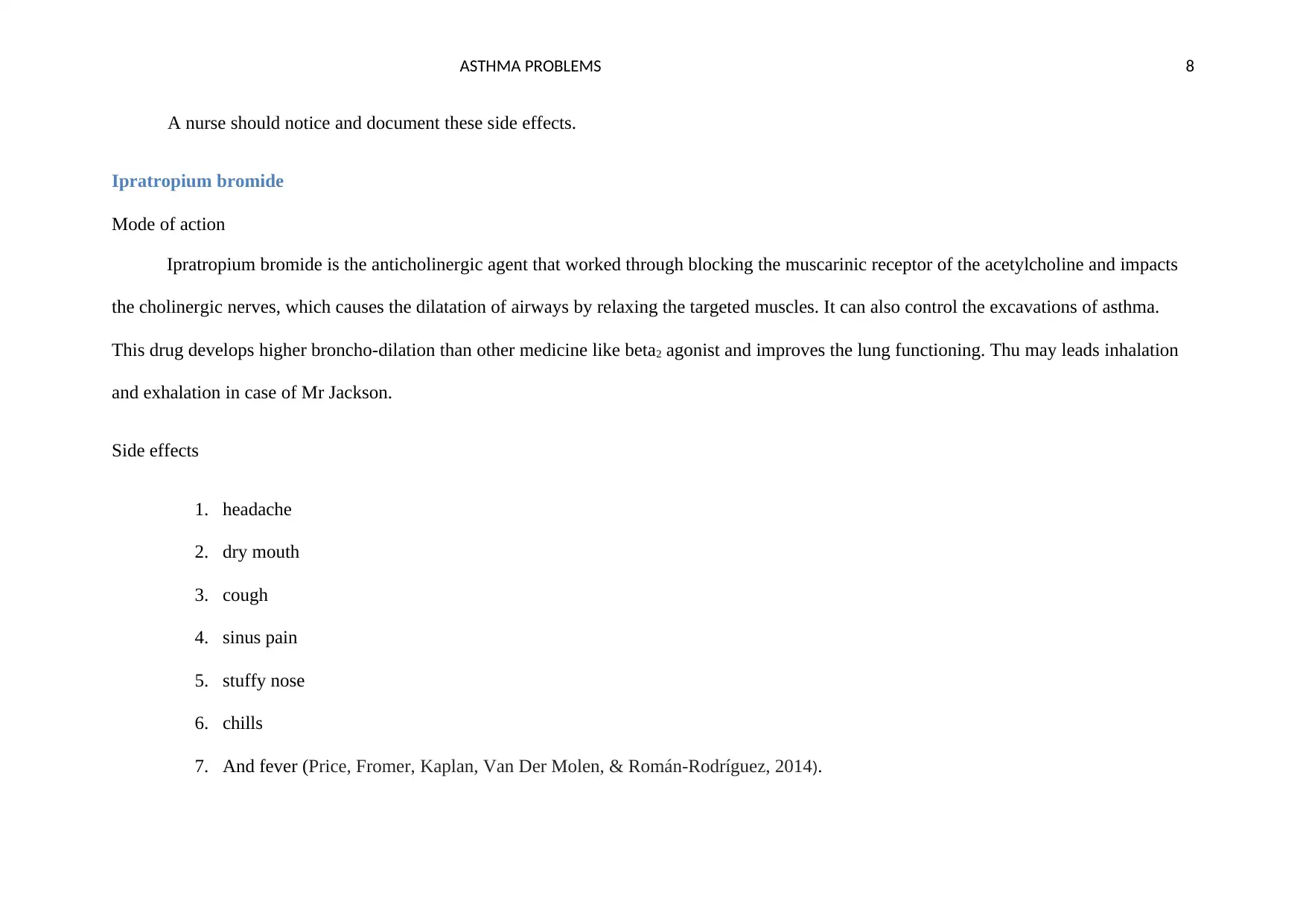
ASTHMA PROBLEMS 8
A nurse should notice and document these side effects.
Ipratropium bromide
Mode of action
Ipratropium bromide is the anticholinergic agent that worked through blocking the muscarinic receptor of the acetylcholine and impacts
the cholinergic nerves, which causes the dilatation of airways by relaxing the targeted muscles. It can also control the excavations of asthma.
This drug develops higher broncho-dilation than other medicine like beta2 agonist and improves the lung functioning. Thu may leads inhalation
and exhalation in case of Mr Jackson.
Side effects
1. headache
2. dry mouth
3. cough
4. sinus pain
5. stuffy nose
6. chills
7. And fever (Price, Fromer, Kaplan, Van Der Molen, & Román-Rodríguez, 2014).
A nurse should notice and document these side effects.
Ipratropium bromide
Mode of action
Ipratropium bromide is the anticholinergic agent that worked through blocking the muscarinic receptor of the acetylcholine and impacts
the cholinergic nerves, which causes the dilatation of airways by relaxing the targeted muscles. It can also control the excavations of asthma.
This drug develops higher broncho-dilation than other medicine like beta2 agonist and improves the lung functioning. Thu may leads inhalation
and exhalation in case of Mr Jackson.
Side effects
1. headache
2. dry mouth
3. cough
4. sinus pain
5. stuffy nose
6. chills
7. And fever (Price, Fromer, Kaplan, Van Der Molen, & Román-Rodríguez, 2014).
⊘ This is a preview!⊘
Do you want full access?
Subscribe today to unlock all pages.

Trusted by 1+ million students worldwide
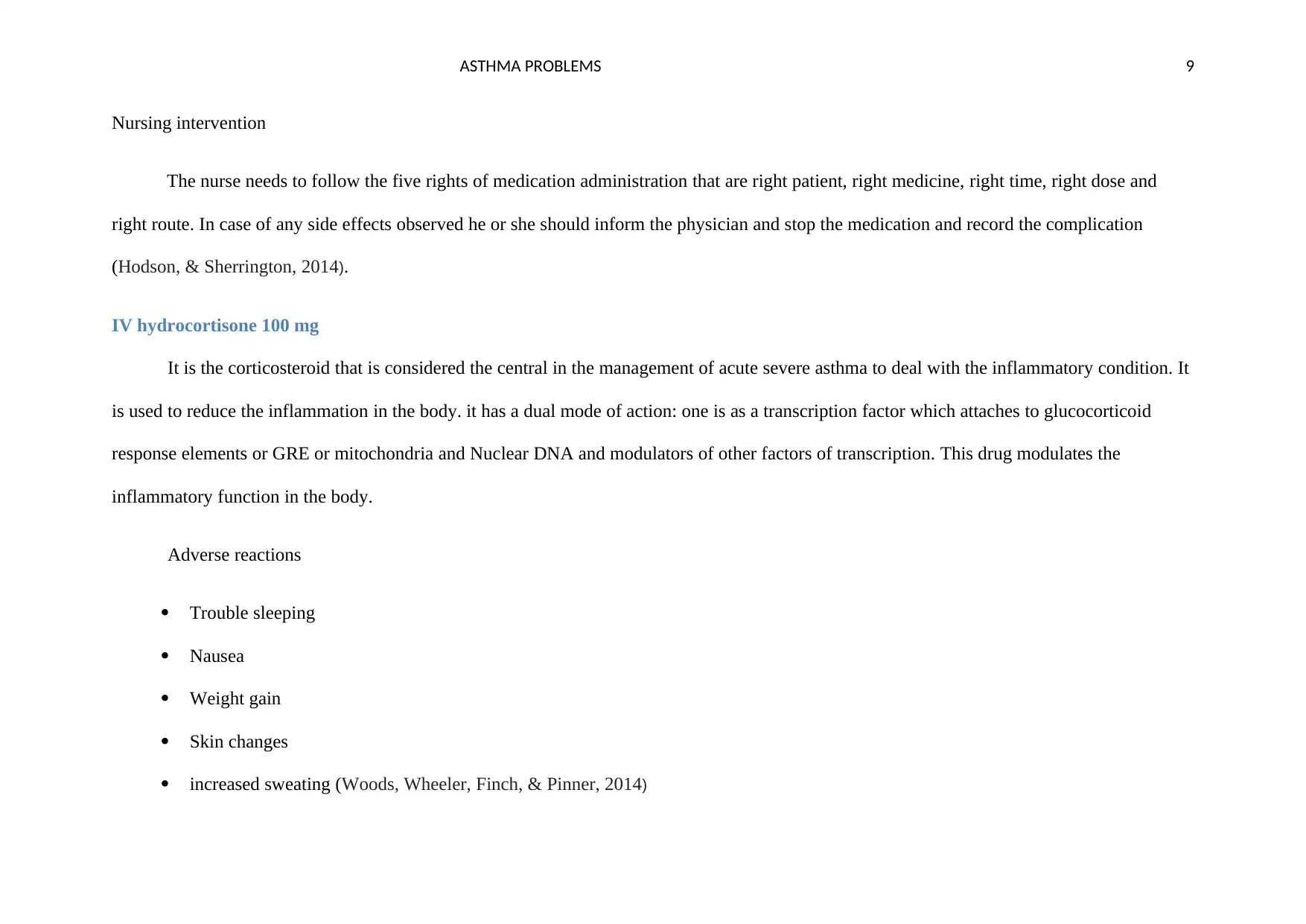
ASTHMA PROBLEMS 9
Nursing intervention
The nurse needs to follow the five rights of medication administration that are right patient, right medicine, right time, right dose and
right route. In case of any side effects observed he or she should inform the physician and stop the medication and record the complication
(Hodson, & Sherrington, 2014).
IV hydrocortisone 100 mg
It is the corticosteroid that is considered the central in the management of acute severe asthma to deal with the inflammatory condition. It
is used to reduce the inflammation in the body. it has a dual mode of action: one is as a transcription factor which attaches to glucocorticoid
response elements or GRE or mitochondria and Nuclear DNA and modulators of other factors of transcription. This drug modulates the
inflammatory function in the body.
Adverse reactions
Trouble sleeping
Nausea
Weight gain
Skin changes
increased sweating (Woods, Wheeler, Finch, & Pinner, 2014)
Nursing intervention
The nurse needs to follow the five rights of medication administration that are right patient, right medicine, right time, right dose and
right route. In case of any side effects observed he or she should inform the physician and stop the medication and record the complication
(Hodson, & Sherrington, 2014).
IV hydrocortisone 100 mg
It is the corticosteroid that is considered the central in the management of acute severe asthma to deal with the inflammatory condition. It
is used to reduce the inflammation in the body. it has a dual mode of action: one is as a transcription factor which attaches to glucocorticoid
response elements or GRE or mitochondria and Nuclear DNA and modulators of other factors of transcription. This drug modulates the
inflammatory function in the body.
Adverse reactions
Trouble sleeping
Nausea
Weight gain
Skin changes
increased sweating (Woods, Wheeler, Finch, & Pinner, 2014)
Paraphrase This Document
Need a fresh take? Get an instant paraphrase of this document with our AI Paraphraser
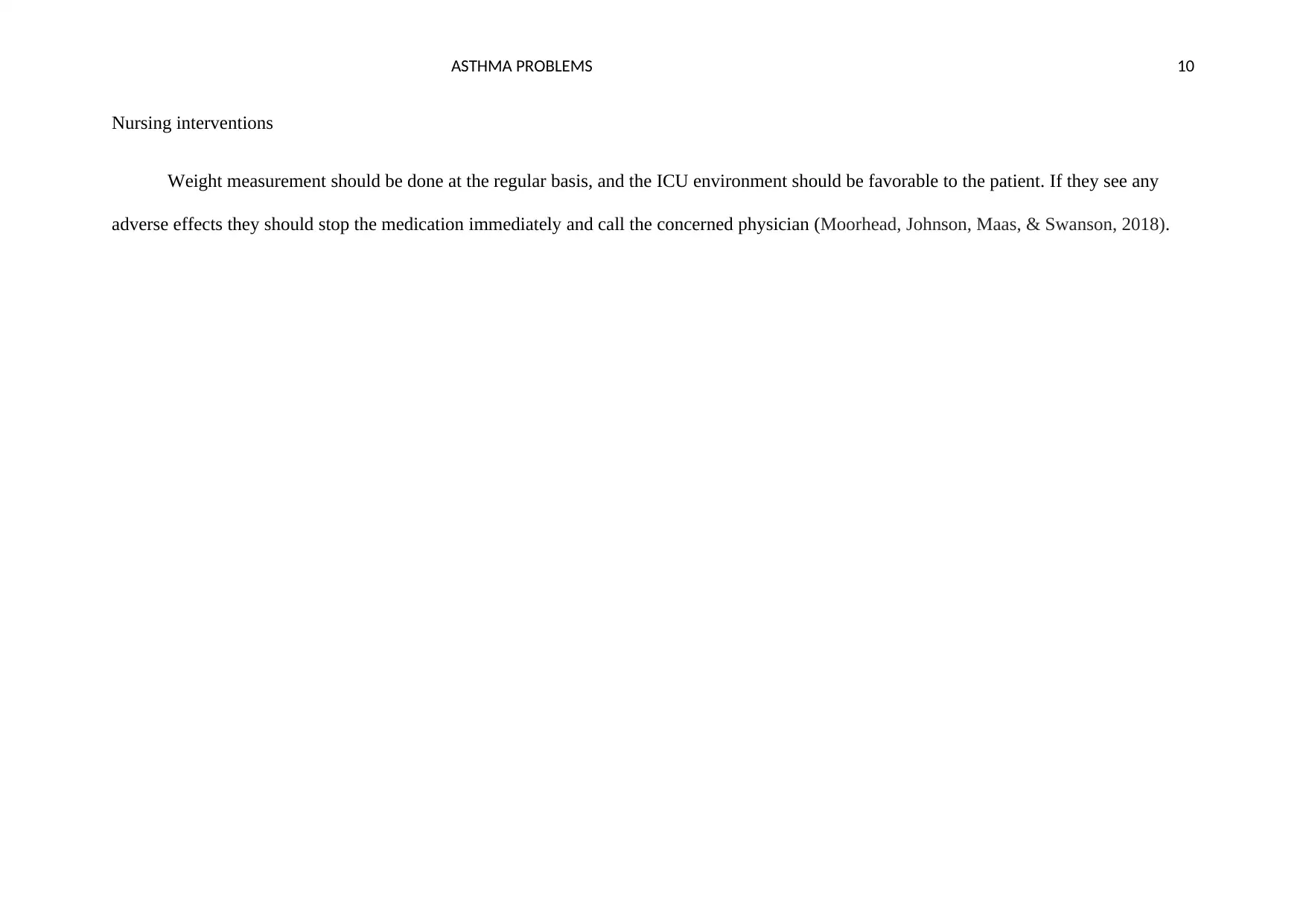
ASTHMA PROBLEMS 10
Nursing interventions
Weight measurement should be done at the regular basis, and the ICU environment should be favorable to the patient. If they see any
adverse effects they should stop the medication immediately and call the concerned physician (Moorhead, Johnson, Maas, & Swanson, 2018).
Nursing interventions
Weight measurement should be done at the regular basis, and the ICU environment should be favorable to the patient. If they see any
adverse effects they should stop the medication immediately and call the concerned physician (Moorhead, Johnson, Maas, & Swanson, 2018).

ASTHMA PROBLEMS 11Aetiology
Infection of respiratory system and allergies
Stressful events
Smoking and air pollution [2]
Pathogenesis
Trigger factor inflammation of airways leads to
Hyper secretion, Airway muscle contraction, Swelling Bronchial
membranes results in
Narrow breathing passage
Wheezing, cough, shortness of breath, tightness in chest
Acute severe asthma [2]
Clinical features
Shortness of breath
Unable to speak full
sentence in single
breath
Agitation
Respiratory rate ≥ 25
BPM [3]
Diagnosis
Medical history
Physical and assessment
Electrocardiogram
Arterial blood gas
analysis
Peak expiratory flow [4]
Complications
tachycardia and
hypokalaemia
sleeplessness,
vomiting, weight
gain, skin changes
headache, dryness of
mouth, sinus pain ,
and cough [2]
Nursing interventions
Stop the medication
Report to the physician
Record [5]
Primary prevention
Provide Oxygen
Administer Corticosteroids
Temporary ventilation support immediately [2]
Treatment
Pharmacological
treatment
1. Nebulised Salbutamol
2. Ipratropium bromide
IV hydrocortisone
100 mg [6]
Nursing strategies
Mechanical
ventilation
Patient education
Making favourable
environment [5]Results in
Causes
Acute severe Asthma
A c u t e s e v e r e a s t h m a a tt a c k t h a t
h a s n o t b e e n i m p r o v e d w i t h t h e
t r a d i ti o n a l [ 1 ]
Risk factor
Asthma patient
Polluted area, exercise [4]
Infection of respiratory system and allergies
Stressful events
Smoking and air pollution [2]
Pathogenesis
Trigger factor inflammation of airways leads to
Hyper secretion, Airway muscle contraction, Swelling Bronchial
membranes results in
Narrow breathing passage
Wheezing, cough, shortness of breath, tightness in chest
Acute severe asthma [2]
Clinical features
Shortness of breath
Unable to speak full
sentence in single
breath
Agitation
Respiratory rate ≥ 25
BPM [3]
Diagnosis
Medical history
Physical and assessment
Electrocardiogram
Arterial blood gas
analysis
Peak expiratory flow [4]
Complications
tachycardia and
hypokalaemia
sleeplessness,
vomiting, weight
gain, skin changes
headache, dryness of
mouth, sinus pain ,
and cough [2]
Nursing interventions
Stop the medication
Report to the physician
Record [5]
Primary prevention
Provide Oxygen
Administer Corticosteroids
Temporary ventilation support immediately [2]
Treatment
Pharmacological
treatment
1. Nebulised Salbutamol
2. Ipratropium bromide
IV hydrocortisone
100 mg [6]
Nursing strategies
Mechanical
ventilation
Patient education
Making favourable
environment [5]Results in
Causes
Acute severe Asthma
A c u t e s e v e r e a s t h m a a tt a c k t h a t
h a s n o t b e e n i m p r o v e d w i t h t h e
t r a d i ti o n a l [ 1 ]
Risk factor
Asthma patient
Polluted area, exercise [4]
⊘ This is a preview!⊘
Do you want full access?
Subscribe today to unlock all pages.

Trusted by 1+ million students worldwide
1 out of 17
Related Documents
Your All-in-One AI-Powered Toolkit for Academic Success.
+13062052269
info@desklib.com
Available 24*7 on WhatsApp / Email
![[object Object]](/_next/static/media/star-bottom.7253800d.svg)
Unlock your academic potential
Copyright © 2020–2025 A2Z Services. All Rights Reserved. Developed and managed by ZUCOL.



